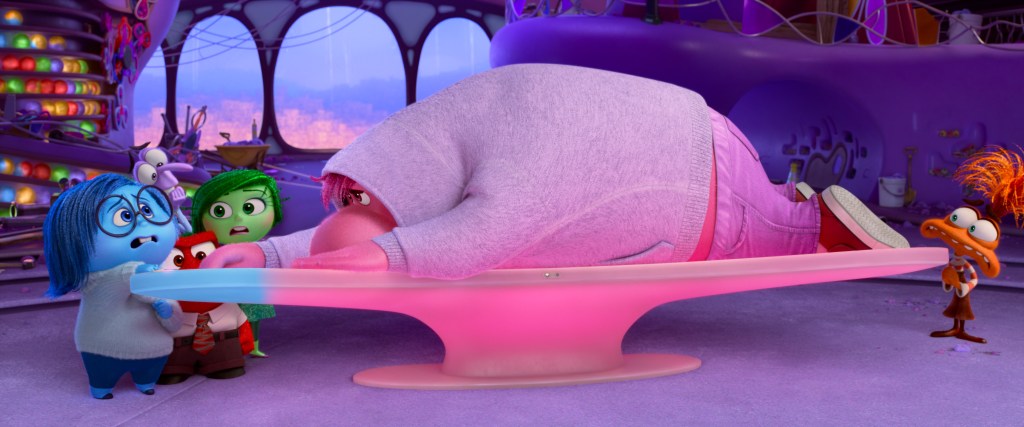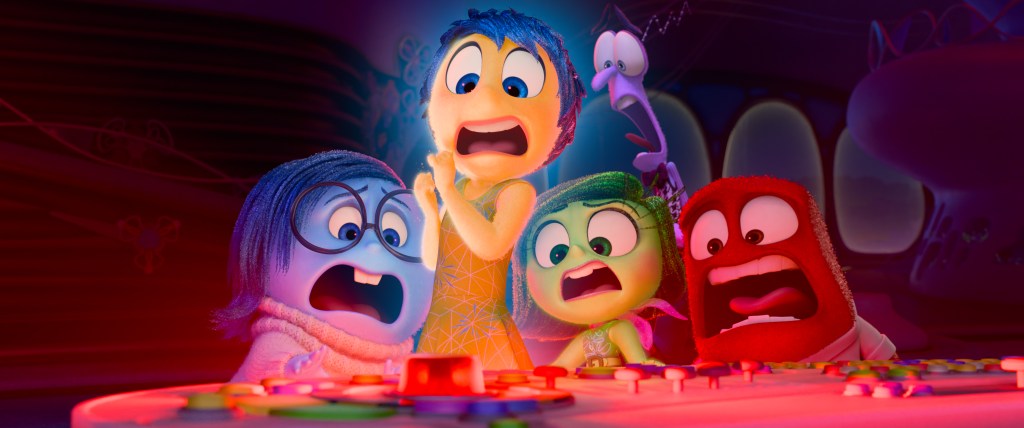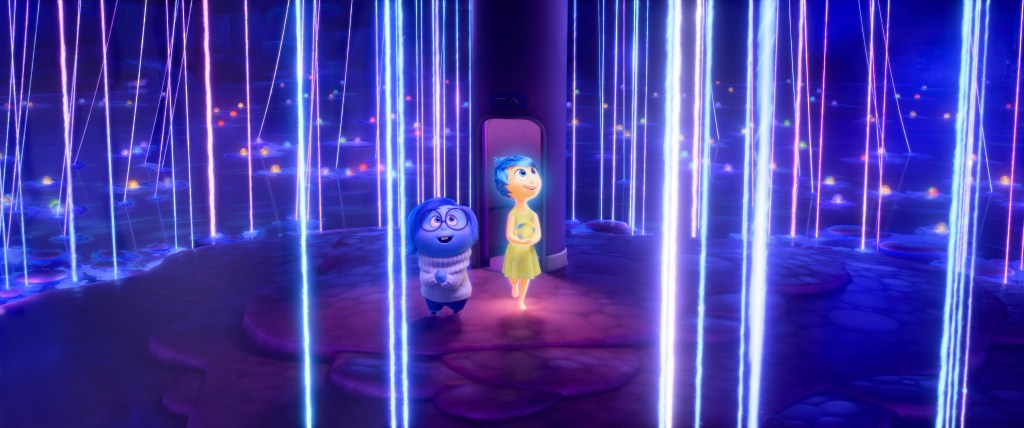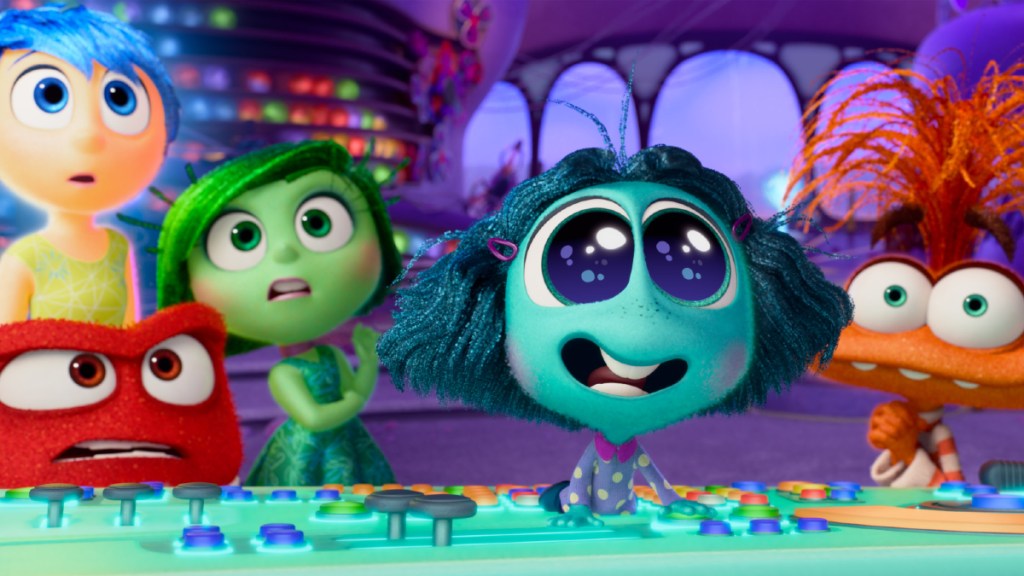Mercifully not as gratingly maudlin as its predecessor, an animated tale of the lives of emotions inside a child’s head, Inside Out 2 doesn’t kill characters for cheap tear-jerking, nor get as dark as suggesting a pre-teen might become a homeless runaway. Unfortunately, it doesn’t substitute anything particularly imaginative in place of such moments.

Well, save one. There’s a sequence that takes place inside the mind, in which a room full of brain cells driven by anxiety are depicted as an animation studio in a literal house of cards, as the anthropomorphized cells at their drawing boards are forced to churn out negative picture after negative picture. All this because the literal Anxiety (Maya Hawke) giving out the orders wants to mitigate damage to the larger body by imagining every possible awful outcome, and squelch any optimism as too risky. This all takes place within a giant pillow fort inside a theme park, of sorts, and is either meant as a really tongue-in-cheek bit of Disney–Pixar self-parody, or a thorough cry for help from the Pixar animators, who, according to recent accounts, will no longer be able to tell personal stories at the expense of more four-quadrant sequels and imagined “sure things.”
Ohmigod…
In a nutshell, Inside Out 2 is saying that the studio animation process of trying to make products with the least amount of risk, as opposed to letting creatives be themselves and tell authentic stories, is comparable to a teenage girl fearfully pretending to only like “cool” stuff in order to fit in. That’s a bold statement and potential feeding-hand bite, but it’s surrounded by a story that otherwise has barely any stakes. Will the now-teenage protagonist Riley (Kensington Tallman) get through summer hockey camp without alienating either her old friends or potential new ones? It’s a dilemma that might feel like the end of the world to a 13 year-old, but never feels like that to this viewer, watching from a distance.

As teased at the end of the prior film, Riley is entering puberty, which brings a larger control terminal and more personified emotions into her headspace. Along with Anxiety, Riley now contends with Ennui (Adele Exarchopolous), Envy (Ayo Edibiri), and Embarrassment (Paul Walter Hauser, though he barely says anything). Anxiety is the one who quickly takes charge, and after effectively saving Riley from an initial social faux pas, seems qualified. Her strategy of preparing for every possible negative eventuality, however, proves as debilitating as anyone with panic attacks could attest.
Nicking the Competition
In its ultimate “obvious metaphor is obvious” moment, Inside Out 2 has the new emotions literally bottle up the old ones and banish them to the far recesses of consciousness. It’s up to Joy (Amy Poehler) to recognize that her own Dianetics-like pattern of finding unhappy emotional moments of the past and individually casting them each aside is the same kind of destructive move. Don’t mistake the plot points in the movie for actual therapeutic solutions; just go with the wordplay and superficial metaphors, like the sar-chasm that makes every echo sound bitchy.
Bing-Bong does not return, but in his place are some new characters that play like surprisingly savage Nickelodeon parodies, at least for Pixar. Without giving away too much, Ron Funches and James Austin Johnson manage to steal the show opposite much bigger names.

At the heart of the story is the quest for Riley’s most authentic sense of self. Is it as an essentially good person who has learned from her mistakes, or a perpetual crisis manager who reacts to every criticism by trying to be ingratiating? Disney itself faces a similar dilemma, as it tries to maximize profits and dodge socio-political issues as much as it can. Judging by some of their creative output, they believe the best heroes stay true to themselves no matter what. Judging by their actions, they aren’t necessarily the heroes.
Too Inside, All Out
It’s a story that’s much more fun when viewed as allegory, though, than as the specific adventures of a girl in hockey camp and her thoughts. There’s something refreshing about a Pixar movie that feels angry rather than sad, and about more than just broccoli on pizza. Ironically, Anger himself (Lewis Black) gets far less to do this time around, the implication perhaps being that adolescence is so confusing it’s hard to know specifically what to be angry at. Interestingly, there was no Pixar short shown before the feature. Did Inside Out 2 scare them all away?

There’s little to truly be scared of, but perhaps not much to lure either. Chip n’ Dale Rescue Rangers was a much funnier Disney self-critique of the business; Inside Out 2 may resonate more with teenage girls, though at times the onscreen teens sound more like the way parents wish they sounded than the reality. The end credits — sit through them for the payoff to one key long-lead gag — dedicate the film to the children of the crew, proclaiming their parents love them just the way they are. Unconditional love is something the kids deserve, but movies have to earn it; Inside Out 2, on the other hand, tries to earn pathos by judicious use of the original movie’s theme. It felt overly calculated for schmaltz the first time around; here, it simply doesn’t work.
Somebody check on all the Pixar animators and make sure they’re okay, though.
Grade: 2.5/5
Inside Out 2 opens in theaters on June 14.





